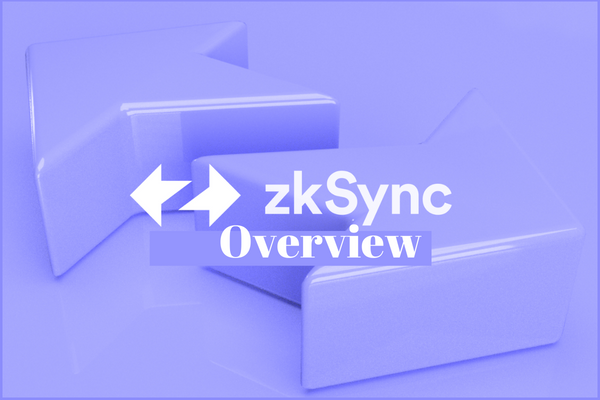Let’s review zkSync, one of the most trending layer 2 scaling solutions for Ethereum.
It uses a technology that kind of flips the blockchain trilemma on its head.
In other words, we can expect fast and cheap transactions, decentralization, and high transactions at once.
Interesting, huh?
Also, zkSync has features that will benefit both users and developers.
Keep reading to the end to see how this protocol works.
Post Summary
Click on any item above to read its details immediately.
Let’s roll!
1. What Is zkSync?

As mentioned, zkSync is a layer 2 scaling solution for Ethereum.
It is designed to achieve fast, cheap, and safe transactions.
Matter Labs, a German-based company launched zkSync in June 2020.
The goal is to provide a protocol that is free of friction and complexity for both users and builders.
zkSync enables you to easily deploy smart contracts, transfer Ethereum-based tokens, explore the services of different DAps, and more.
Let’s see how this protocol works in the next section.
Keep reading!
2. How zkSync Works

First of all, let’s understand the technology behind the protocol.
zkSync operates with zkRollup technology.
zk stands for zero-knowledge and rollup refers to a collection of transactions.
Also, the “zero-knowledge” means that transactions are validated but no proof is provided.
Think of it as a “trust me on this” method of verification.
I’ll explain…
Let’s say you dialed a friend working at a supermarket requesting the price of a book.
He responds with N500, and you go to the supermarket with that amount to get the book.
Now, he didn’t have to send you a picture of the book and the price tag to convince you.
You simply believed him because he works there.
Similarly, zkrollups validate transactions without bothering with providing any proof.
This helps to finalize many transactions faster.
Furthermore, zkSync uses both off-chain and on-chain data to secure transactions.
All funds are held by a smart contract on the main chain, while computation and storage are performed off-chain.
That way, many transactions are “rolled up” to a single item, verified, and approved simultaneously. Cool!
As of July 2022, zkSync can boast of 2000 TPS, 10 minutes transaction finality, instant confirmations, cheap transactions (almost 100 times lower than Ethereum), and an uncongested mainnet.
You can read this doc file to get more details on how zkSync works.
Moving on, let’s see what you can do with this protocol.
Tag along!
3. Who Can Use zkSync?
Anyone who is interested in Ethereum-scaling solutions can use zkSync.
And like I said earlier, zkSync is designed for both users and developers.
Developers can comfortably build on or integrate their apps with zkSync.
They can deploy smart contracts, build exchanges, payment systems, enable atomic swaps, etc.
If that’s your sphere, you can check out the developer docs to learn more.
On the other hand, as a regular user, you can do the following zkSync:
- Transfer funds across different Ethereum wallets
- Mint NFTs
- Trade on the supported exchanges and DeFi platforms at a low cost (e.g. ZigZag, Yearn finance, 1inch)
To get started, follow these steps:
- Visit zkSync.io and connect your wallet to the zkSync wallet.
- Next, you fund your account and activate it.
- Then explore the various apps on the zkSync ecosystem.
See a pictorial guide here.
So, does zkSync have a bright future, or, is it likely to fade soon?
Read the next section to know what I think.
4. What Does The Future Hold For zkSync?
I see a bright future for this protocol because of the solution it brings to the table.
It facilitates fast and cheap transactions.
Also, it provides tools that both developers and users find useful.
Additionally, the founding company, Matter Labs, is solely dedicated to providing scaling solutions for Ethereum.
So, we can expect consistent improvements in the protocol.
Moreover, there is a plan to release the zkSync V2 version once ETH2 data sharding is available.
This will increase the protocol’s throughput to over 100,000 TPS and support arbitrary smart contract capabilities.
And I am not the only one who believes in this protocol’s potential.
When you look at the zkSync homepage, you’ll find top platforms like Blockchain.com, Binance, Coinbase, etc. listed as backers.
Besides, it has raised a total of $258 million in two seed rounds. Cool!
Furthermore, the zkSync intends to launch a native token later.
The native token will be used for staking and more.
Plus, users of the zkSync network could likely be rewarded with an airdrop.
Therefore, you may want to start interacting with the protocol now in order to partake in the airdrop.
See other protocols that may soon release airdrops here.
Special Offer!

If you want to learn how to trade cryptocurrencies profitably, we developed a perfect course to help you master Cryptocurrency Trading.
Go to www.ctmastery.com to enroll.
You can also join our Telegram community at https://t.me/ctmastery for more information.
5. Conclusion
zkSync is a layer 2 scaling solution that uses zkRollup technology to enable fast and cheap Ethereum transactions.
It was designed with both developers and users in mind.
That’s all I have for you in this post. I hope you enjoyed the read.
Over to you;
What’s your take on zkSync? Do you think its zkRollup technology is the way to go?
Are there other scaling solutions you feel are doing better than zkSync?
Let me hear your thoughts in the comments section.
Also, hit those SM icons to share this post with your friends, thank you!



0 Comments